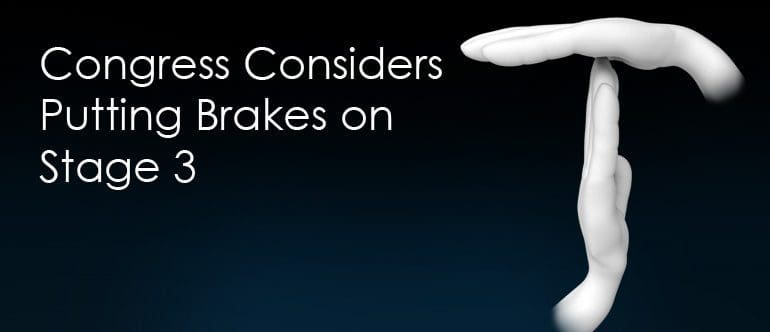Call us toll-free: 800-878-7828 — Monday - Friday — 8AM - 5PM EST


By Joseph Goedert for HealthData Management
Federal lawmakers are noticing some dark clouds surrounding the electronic health records meaningful use program to prod providers to adopt EHRs. With rising recent struggles in the program, lawmakers may be poised to intervene to push back the program’s third stage.
Problems with the current stage are all too apparent. As of mid-June 2015, 11 percent of eligible physicians have participated in Stage 2 of the electronic health records financial incentive program, and 42 percent of eligible hospitals have participated.
Now, there are rumblings in Congress about delaying Stage 3, which is supposed to start with an optional year in 2017 and with all participants moving to the third stage in 2018.
Sen. Lamar Alexander (R-Tenn.), chair of the Senate Health, Education, Labor & Pensions Committee, is broaching the subject of delaying Stage 3, and this month even mentioned the idea to Health and Human Services Secretary Sylvia Burwell. At a committee meeting, Alexander discussed his talk with Burwell and added: “There’s been some discussion about delaying Meaningful Use Stage 3, about whether it’s a good idea, whether it’s a bad idea, whether to delay part of all of it. My instinct is to say to Secretary Burwell, ‘Let’s not go backwards on electronic healthcare records.’ ”
Alexander also said it may be wise to slow down Stage 3, “not with the idea of backing up on it, but with the idea of saying, ‘Let’s get this right.’ ” At the same committee meeting, David Kibbe, MD, president and CEO of DirectTrust, a coalition of 150 organizations supporting the Direct secure messaging protocols, recommended “an immediate moratorium on Stage 3 until Stage 2 is fixed.”
Early Warnings of Problems
When the Centers for Medicare and Medicaid Services issued a proposed rule for Stage 2, many stakeholders protested that the objectives and measures were too burdensome or simply unrealistic. It became clear that CMS should have listened more closely when, in April 2015, the agency was obliged to significantly ease several troublesome objectives, eliminate about a dozen Stage 2 measures that were considered redundant or adequately adopted, and provide more flexibility for meaningful use reporting periods.
At about the same time, CMS issued a proposed rule for Stage 3, and it didn’t get a warm reception from providers concerned that proposed measures are not realistic in real-world settings and that the technology is not going to be mature enough to support the measures.
Other concerns are plaguing EHR technology. For example, the American Medical Association in late 2014 released a framework to prioritize EHR usability woes. The AMA says its members are complaining about usability caused by ill-conceived EHR clinical workflows, time-consuming data entry, interference with face-to-face patient care and overwhelming fatigue with electronic messages and alerts.
The plan includes ways to enhance physicians’ ability to provide quality care, support team-based care, promote care coordination, offer product modularity and configurability, reduce cognitive workloads, promote data liquidity, facilitate digital and mobile patient engagement, and expedite user input into product design and post-implementation feedback.
Legislators Take Notice
Congress has taken notice, spurred by the AMA and other trade associations, such as the American Hospital Association, Healthcare Information Management and Systems Society and the Medical Group Management Association. Members of the Senate, in particular, have shown increased interest in the performance of the meaningful use program, in large part because of usability issues that have impeded health information exchange and care coordination, and some members now are questioning whether the program continues to have value and how to fix it.
The Senate HELP Committee recently heard testimony from industry stakeholders on two major barriers to interoperability: exorbitant costs for interfaces, the practice of providers or their EHR vendors in deliberately blocking data exchange.
Lack of exchange and interoperability is not all the fault of EHR companies. At the hearings, vendor Allscripts fired back, with CEO Paul Black telling the committee that many providers aren’t pushing for interoperability because the current healthcare payment system does not provide financial incentives for them to interoperate, meaning the providers would have to absorb costs they cannot afford. In short, there often is a lack of a strong business case to exchange data, Black said.
The College for Healthcare Information Management Executives, which represents information technology leaders, recently sent a letter to the Senate HELP Committee reminding members that Congress itself has seriously impeded health information exchange with some of its policies. CHIME is unleashing its 1,600 members to press Congress to remove the congressionally mandated prohibition on a national patient identifier.
In its letter, CHIME calls the lack of a consistent patient identity matching strategy “the most significant challenge inhibiting the safe and secure electronic exchange of health information. As our healthcare system begins to realize the innately transformational capabilities of health IT, moving toward nationwide health information exchange, this essential core functionality—consistency in patient identity matching—must be addressed.”
The group emphasized that a consistent strategy does not require using a single technology or solution, but a solution must be found. “Robust information exchange and interoperability can flourish only once we can confidently identify a patient across providers, locations and vendors.”
Debate over the value of meaningful use and the ability to exchange health information is critically important as the nation’s healthcare system rapidly shifts to accountable care, which will place high priority on population health management and value-based reimbursement.
